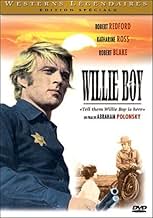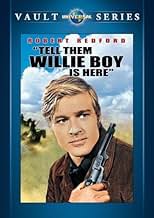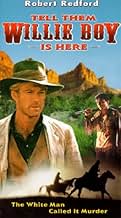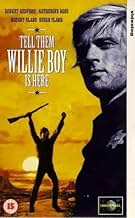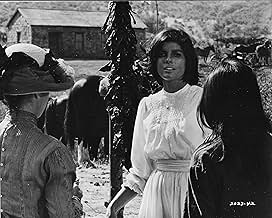Em 1909, quando o jovem indígena Paiute Willie Boy retorna à sua reserva, na Califórnia, para ficar com Lola, cujo pai o desaprova, um assassinato em legítima defesa ocorre, desencadeando um... Ler tudoEm 1909, quando o jovem indígena Paiute Willie Boy retorna à sua reserva, na Califórnia, para ficar com Lola, cujo pai o desaprova, um assassinato em legítima defesa ocorre, desencadeando uma enorme caçada humana por Willie.Em 1909, quando o jovem indígena Paiute Willie Boy retorna à sua reserva, na Califórnia, para ficar com Lola, cujo pai o desaprova, um assassinato em legítima defesa ocorre, desencadeando uma enorme caçada humana por Willie.
- Direção
- Roteiristas
- Artistas
- Ganhou 2 prêmios BAFTA
- 3 vitórias e 1 indicação no total
- Digger
- (as Eric Holland)
- Meathead
- (as Lee De Broux)
- Direção
- Roteiristas
- Elenco e equipe completos
- Produção, bilheteria e muito mais no IMDbPro
Avaliações em destaque
The film covers several genres & comments upon them in interesting ways: it is a Western w. conventional themes (turned upside down & inside out) of Indian savages vs. white civilizers; it is a historical drama that chronicles the rise to power of the industry elites in late 19th century CA. (illustrated in the subplot of Pres. Taft's visit to the Riverside Inn). While this is a Western, it might be better termed an anti Western. Every character (including Blake's Indian) is weak, vacillating & morally changeable, which makes for a wonderfully complex tale.
Blakes dialogue gives us the film's title: "Well, at least they'll know that Willie Boy was here." He says this in responding to Katherine Ross' comment asking why he is willing to keep running, even though the whites will eventually trap & kill him. This scene conveys the film's elegaic tone about the death of the "romantic" West & the rise of the homogenized, white, industrial CA. that would arise in the 20th century. Willie is compelled to stand up for his own individuality even though in actuality few will mourn his passing & even fewer remember that "he was here." But Polonsky, the filmmaker, tells us that someone will indeed remember Willie beyond those tracking him down & exterminating him: Polonsky himself & the viewers of the film. Really cool stuff!
Another powerful layer of history is Abraham Polonsky's involvement. As a Hollywood 10 member, the script seems to comment indirectly on the Hollywood Blacklist era. Blake the hounded Indian is much like the renegades of the Hollywood 10. Willie Boy tries to stand up for the principle of honor & freedom in the face of insurmountable social odds. Yet, he is never seen as a romanticized or one sided character. Even Willie Boy is pig headed, monomaniacal and self-destructive.
I think Blake does a great job in this role. It makes you remember how good he could be in film roles (remember "In Cold Blood?") before "Baretta" came along. And it makes you weep for his recent descent into hell & wonder at what might have been if his life & career had taken diff. turns.
I didn't mind Katherine Ross as much as some viewers. She was much less bothersome & stereotypical than in some of her other roles ("The Graduate" & "Butch Cassidy"). During the film I was actually realizing how much I liked her in her role which surprised me.
I highly recommend this film.
Blake's character is a Paiute Indian who is the object of a manhunt which is sensationalized by the press because of its concurrence with a visit by President Taft. The sheriff is pressured into hunting down the Indian and the girl he loves but whose father has forbidden the match.
It's a good solid early-1900s Western with much better-than-average acting. But it's not so much an action film as it is a character study -- of Blake's character and, to a lesser degree, Redford's. It brings to life the racism and exploitation that white Europeans brought with them to America.
yes, it raises all the cross-culture misunderstandings, thats what makes it so tragic and so good. it makes you stop and think before you make that next assumption about someone you don't know....whose culture your only vaguely familiar with..not a bad thing to do today, then or anytime.
Every scene is painfully slow in getting to the payoff so that the film seems a lot longer than one hour and thirty-six minutes. The first hour is devoted to the manhunt for an Indian killer (Blake) and then the plot involves the arrival of President Taft in 1909 California and the effort to protect him from any kind of assassination attempt.
Redford's role as the reluctant sheriff is never too clear since he's a man of a very few words (a regular Gary Cooper type), so it's up to Blake to carry much of the film and he does. He's terrific as the Indian lad who's trigger happy when the posse starts getting too close.
The last twenty minutes should have been a model of suspense as they close in on Willie Boy, but it's allowed to drag out interminably.
Summing up: Character driven tale had the potential to be a fine western, but badly paced direction of Abraham Polonsky is no help nor is the sluggish script. Film was released after BUTCH CASSIDY AND THE SUNDANCE KID put Redford on the map but was never a big box-office success.
Você sabia?
- CuriosidadesAbraham Polonsky said to a USC film class at the time that he purposely shot and edited the manhunt sequences with characters moving in all directions across the screen, rather than in the usual way wherein both runners and pursuers would move in the same direction across the shots (i.e., left to right) to enhance the impression of urgent suspense in a chase. Instead, Polonsky was looking for a different feel for the audience, of the characters wandering, feeling their way through the landscape. He implied he was willing to sacrifice some suspense to externalize the characters' confusion. He also said that for Katharine Ross' brief, artfully lit nude shot, he exposed the film correctly but then produced a high-contrast copy of the same film frames with deep blacks and transparent lights, then bi-packed both pieces of films together to rephotograph. The high-contrast overlay ensured that the shadows on Ross' body were black--so that the image could not reveal more in the shadows than it was supposed to.
- Erros de gravaçãoMany of the hats worn in the film are not the style worn during the early part of the 20th century. Some in fact, could only have been sewn using machines created in the 1950s, nearly half a century after the film's setting.
- Citações
Dr. Elizabeth Arnold: Willie killed Mike and took Lola. They call it marriage by capture. The mother knew that and told her to go.
- ConexõesFeatured in A Hollywood Vermelha (1996)
Principais escolhas
- How long is Tell Them Willie Boy Is Here?Fornecido pela Alexa
Detalhes
- Data de lançamento
- País de origem
- Idioma
- Também conhecido como
- Willlie Boy, o Rebelde
- Locações de filme
- Pioneertown, Califórnia, EUA(shoot out near end, Pipes Canyon)
- Empresa de produção
- Consulte mais créditos da empresa na IMDbPro
Bilheteria
- Faturamento bruto mundial
- US$ 5.949
- Tempo de duração
- 1 h 38 min(98 min)
- Cor
- Proporção
- 2.39 : 1


